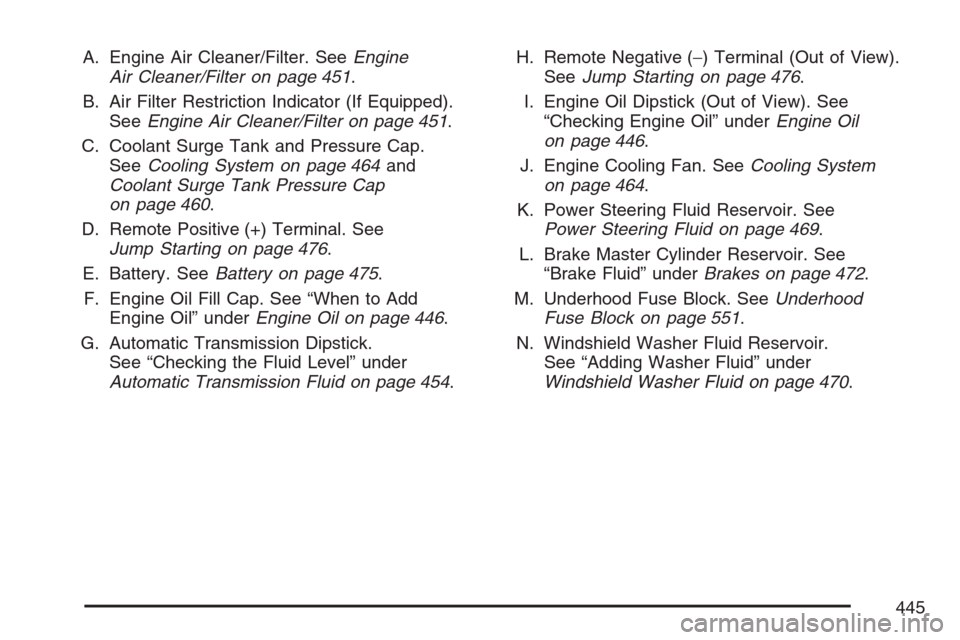Page 445 of 618

A. Engine Air Cleaner/Filter. SeeEngine
Air Cleaner/Filter on page 451.
B. Air Filter Restriction Indicator (If Equipped).
SeeEngine Air Cleaner/Filter on page 451.
C. Coolant Surge Tank and Pressure Cap.
SeeCooling System on page 464and
Coolant Surge Tank Pressure Cap
on page 460.
D. Remote Positive (+) Terminal. See
Jump Starting on page 476.
E. Battery. SeeBattery on page 475.
F. Engine Oil Fill Cap. See “When to Add
Engine Oil” underEngine Oil on page 446.
G. Automatic Transmission Dipstick.
See “Checking the Fluid Level” under
Automatic Transmission Fluid on page 454.H. Remote Negative (−) Terminal (Out of View).
SeeJump Starting on page 476.
I. Engine Oil Dipstick (Out of View). See
“Checking Engine Oil” underEngine Oil
on page 446.
J. Engine Cooling Fan. SeeCooling System
on page 464.
K. Power Steering Fluid Reservoir. See
Power Steering Fluid on page 469.
L. Brake Master Cylinder Reservoir. See
“Brake Fluid” underBrakes on page 472.
M. Underhood Fuse Block. SeeUnderhood
Fuse Block on page 551.
N. Windshield Washer Fluid Reservoir.
See “Adding Washer Fluid” under
Windshield Washer Fluid on page 470.
445
Page 446 of 618
Engine Oil
If the CHECK OIL LEVEL message in the Driver
Information Center (DIC) comes on, check the
engine oil level right away. For more information,
see CHECK OIL LEVEL underDIC Warnings and
Messages on page 267. You should check the
engine oil level regularly; this is an added reminder.
Checking Engine Oil
It is a good idea to check the engine oil every time
you get fuel. In order to get an accurate reading,
the oil must be warm and the vehicle must be
on level ground.The engine oil dipstick handle is a yellow loop.
SeeEngine Compartment Overview on page 444
for the location of the engine oil dipstick.
1. Turn off the engine and give the oil several
minutes to drain back into the oil pan. If you
do not do this, the oil dipstick might not
show the actual level.
2. Pull out the dipstick and clean it with a paper
towel or cloth, then push it back in all the
way. Remove it again, keeping the tip down,
and check the level.
446
Page 447 of 618
When to Add Engine Oil
If the oil is below the cross-hatched area at the
tip of the dipstick, you need to add at least
one quart/liter of oil. But you must use the right
kind. This section explains what kind of oil to use.
For engine oil crankcase capacity, seeCapacities
and Speci�cations on page 556.
Notice:Do not add too much oil. If the engine
has so much oil that the oil level gets above
the cross-hatched area that shows the
proper operating range, the engine could
be damaged.SeeEngine
Compartment Overview
on page 444for the
location of the engine
oil �ll cap.
Be sure to add enough oil to put the level
somewhere in the proper operating range.
Push the dipstick all the way back in when
you are through.
447
Page 454 of 618

Automatic Transmission Fluid
When to Check and Change Automatic
Transmission Fluid
A good time to check your automatic transmission
�uid level is when the engine oil is changed.
Change the �uid and �lter at the intervals listed in
Additional Required Services on page 566, and
be sure to use the transmission �uid listed in
Recommended Fluids and Lubricants on page 574.
How to Check Automatic
Transmission Fluid
Because this operation can be a little difficult, you
may choose to have this done at the dealership
service department.
If you do it yourself, be sure to follow all the
instructions here, or you could get a false
reading on the dipstick.Notice:Too much or too little �uid can
damage your transmission. Too much can
mean that some of the �uid could come out
and fall on hot engine parts or exhaust system
parts, starting a �re. Too little �uid could
cause the transmission to overheat. Be sure to
get an accurate reading if you check your
transmission �uid.
Wait at least 30 minutes before checking the
transmission �uid level if you have been driving:
When outside temperatures are above
90°F (32°C).
At high speed for quite a while.
In heavy traffic — especially in hot weather.
While pulling a trailer.
To get the right reading, the �uid should be
at normal operating temperature, which is
180°F to 200°F (82°C to 93°C).
454